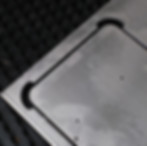All-in-one POS system and integrated back office suite built for grocery.
Vori

Vori is Series A startup based in San Francisco on a mission to modernize B2B operating system for the grocery industry. The integrated system connects data across the food supply chain, streamlining operations for grocers and suppliers while democratizing food supply access.
-
Hardware is the first customer touchpoint and impression, but it failed to reflect the team's work, brand, or vision.
-
Assembling hardware from Amazon parts is flimsy and unreliable, often requiring service calls for minor issues.
-
On-site assembly of hardware and parts was time-consuming, inefficient, and often created friction with new customers and store owners.
-
Custom made sheetmetal parts and 3D printed hardware enclosures to streamline hardware assembly, enable hardware preparation to be done off-site and making lane integration more efficient.
-
Delivered well-crafted hardware experiences at the same cost as ad-hoc Amazon builds.
-
From the 300+ units dispatched, less than less 5 service calls related to POS hardware were received.
-
Reduced on-site installation time by 30% making the POS hardware integration more streamlined.
-
Jeff Lin, Chris Matsuda
Summer 2021
Crafting hardware experiences for early-stage startup is difficult and cost prohibitive. Many hack together parts from Amazon and with some double sided tape.

We redesigned both sides of the Vori POS to craft early adopter experience and optimize the hardware rollout at no additional cost.
Cashier POS-The large touch display and numpad allow cashiers to navigate the interface quickly, while the wide bottom bar provides space for posting "cheat sheets" as needed.
The iPad display and payment terminal work together to let shoppers review their items and complete checkout. The card slot is highlighted in Vori’s brand color to make it easy to locate.




Advancements in 3D printing make it a powerful tool for early-stage startups, enabling design implementation early in the development process.

Traditionally, producing a casted part require a high sunk cost and MOQ and this is a high risk for startups. Recent advancements in 3D printing is allowing early stage startups to craft hardware experience quickly and in small numbers.
Low volume production is feasible—3D printing enables customer ready low volume production. We optimized designs for 3D printing by increasing yield, reducing support-heavy overhangs, and incorporating snap-fit features aligned with layer orientation for greater durability.
Eliminates production cost barrier—Advances in 3D printing have made low-volume production more practical, offering early-stage startups a reliable, efficient, and cost-effective path to develop hardware products.
Makes rapid iteration possible—Traditionally, integrating detailed feedback into hardware development has been costly and slow. Additive manufacturing enables agile, budget-conscious startups to iterate quickly, respond to user input, and strengthen customer engagement.
Shortened lead time to get to market quickly—3D printing allows startups to reach customers faster and more predictably than traditional manufacturing, which requires long lead times for factory setup. With additive manufacturing, speed to market depends mainly on print time and printer availability—enabling scalable, on-demand production.
Craft brand experiences early on—Cost, time, and speed constraints often lead startups to patch together off-the-shelf parts to accelerate development. While effective early on, this approach can compromise brand identity and design cohesion—both as essential as functionality when delivering a compelling product.
Designed for 3D printing with features that enhance perceived quality, reduce yield issues, and extend product lifespan.

Traditional snap feature geometries are not suitable for 3D printing. We invented a new snap feature geometry that leverages layer orientation and material flexibility to secure hardware within the enclosure. After hundreds of test cycles, the fit remained strong and reliable.

We oriented customer-facing surfaces to print flat on the bed, allowing us to apply front-facing textures while hiding layer lines along the sides.

While color options were limited, using colored filaments instead of paint ensured long-lasting, high-quality finishes that hold up in customer-facing environments.

We partnered will local factory Hill Manufacturing in San Jose to stay close to production.

Aluminum sheetmetal waterjet

A powder-coated finish adds texture, resists fingerprints, and helps the surface appear clean over time.

Contributing to Vori’s Series A success through impact-driven and what-is-appropriate design.
Through this initiative, Vori successfully rolled out its POS system to early customers and adopters during their Series A with clear improvements in their success metrics.
%20(1)_gif.gif)

Reduce onsite installation time by half—with built-in cable management and assembly features, Vori’s operations team reduced average per-lane installation time from 60 minutes to 30 minutes—a 50% improvement in efficiency.
Eliminated installation longevity concerns—the initial POS hardware was assembled using off-the-shelf metal brackets and double-sided taped together and deployed to customer storefronts. We changed that.
Elevated brand experience at no additional cost—we delivered an elevated customer experience and improved operational efficiency—at no additional cost compared to the original deployment COGs. This was made possible by leveraging accessible 3D printing technologies and working with a local Bay Area fabrication shop.
Reaching their customer is key for many early stage startups. Over 300 Vori POS units were deployed over 18 months meeting their Series A milestones.

Bringing teams together to co-create and build on each other's learnings and insights to build the right thing.









